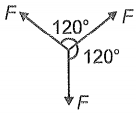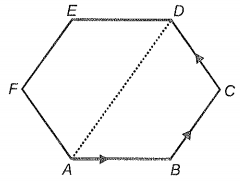Work done by a force (\(F\)) in displacing a body by dx is given by W=. If the force is given as a function of displacement (\(x\)) by \(F \left(x\right) = \left( x^{2} - 2 x + 1\right) \text{N}\), then work done by the force from \(x=0\) to \(x=3\) m is:
1. \(3\) J
2. \(6\) J
3. \(9\) J
4. \(21\) J
The impulse due to a force on a body is given by \(I=\int Fdt\). If the force applied on a body is given as a function of time \((t)\) as \(F = \left(3 t^{2} + 2 t + 5\right) \text{N}\), then impulse on the body between \(t = 3~\text{s}\) to \(t =5~\text{s}\) is:
1. \(175\) kg-m/sec
2. \(41\) kg-m/sec
3. \(216\) kg-m/sec
4. \(124\) kg-m/sec
Which of the following option is not true, if and , where \(\mathrm{A}\) and \(\mathrm{B}\) are the magnitudes of ?
1.
2.
3.
4. \(\mathrm{A}=5\)
In the space, if the sum of vectors of unequal magnitude is zero, then the minimum number of vectors are:
1. \(2\)
2. \(3\)
3. \(4\)
4. \(5\)
If is perpendicular to , then which of the following statement is correct?
1.
2.
3.
4.
The angle between the two vectors \(\left(- 2 \hat{i} +3 \hat{j} + \hat{k}\right)\) and \(\left(\hat{i} + 2 \hat{j} - 4 \hat{k}\right)\) is:
1. \(0^{\circ}\)
2. \(90^{\circ}\)
3. \(180^{\circ}\)
4. \(45^{\circ}\)
If ; then which of the following statements is incorrect?
(1) must each be a null vector.
(2) The magnitude of equals the magnitude of .
(3) The magnitude of ä can never be greater than the sum of the magnitudes of and
(4) ä must lie in the plane of and .
When a force of magnitude F acts on a body of mass m the acceleration produced in the body is a. If three coplanar forces of equal magnitude F act on the same body as shown in the figure, then acceleration produced is

1. 0
2.
3.
4.
Three forces each of magnitude 1 N act along with the sides AB, BC, and CD of a regular hexagon. The magnitude of their resultant is:

(1) 4N
(2) Zero
(3) 2 N
(4) 1 N


